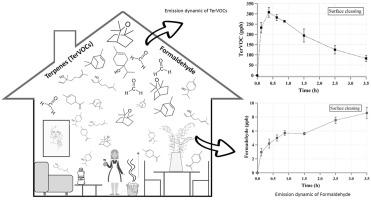当前位置:
X-MOL 学术
›
Atmos. Environ.
›
论文详情
Our official English website, www.x-mol.net, welcomes your
feedback! (Note: you will need to create a separate account there.)
Indoor use of essential oil-based cleaning products: Emission rate and indoor air quality impact assessment based on a realistic application methodology
Atmospheric Environment ( IF 4.2 ) Pub Date : 2021-02-01 , DOI: 10.1016/j.atmosenv.2020.118060 S. Angulo Milhem , M. Verriele , M. Nicolas , F. Thevenet
Atmospheric Environment ( IF 4.2 ) Pub Date : 2021-02-01 , DOI: 10.1016/j.atmosenv.2020.118060 S. Angulo Milhem , M. Verriele , M. Nicolas , F. Thevenet

|
Abstract Cleaning is performed to increase hygiene, esthetics and material preservation. Despite its benefits, cleaning also poses risks, potentially contributing to nearly 20% of indoor pollution. As indoor air quality has become a major human health concern, “natural-scented” cleaning products, formulated with essential oils, have become market leaders among household products. However, these consumer products have benefitted from skillful marketing strategies based on the ambiguity of the words “green” and “natural”. The characterization of the emission processes studied through 1-m3 chamber experiments under a realistic scenario suggests variable maximum total terpene concentrations from 150 to 300 ppb. The estimated emission rate profiles confirm that the liquid-to-gas transfer of terpenes is driven by (i) the formulation of the product matrix inducing specific chemical affinities, (ii) the liquid content of individual terpenes, and (iii) the intrinsic volatility of terpenes. A unique formaldehyde emission kinetics profile was observed, suggesting the presence of a unique emission source: formaldehyde-releasers. Consequently, the use of essential-oil-based cleaning products might generate a long-term increase in the indoor formaldehyde concentration, and the maximum levels might be sustained for several hours after cleaning. Thus, essential-oil-based cleaners should be seriously considered as versatile and significant sources of fragrance molecules and formaldehyde.
中文翻译:

基于精油的清洁产品的室内使用:基于实际应用方法的排放率和室内空气质量影响评估
摘要 进行清洁是为了提高卫生、美观和材料保护。尽管有好处,但清洁也带来风险,可能导致近 20% 的室内污染。由于室内空气质量已成为一个主要的人类健康问题,含有精油的“天然香味”清洁产品已成为家居产品的市场领导者。然而,这些消费品得益于基于“绿色”和“天然”两个词的歧义的巧妙营销策略。在现实情景下通过 1 立方米室实验研究的排放过程的特征表明,萜烯总浓度的最大变化范围为 150 至 300 ppb。估计的排放率曲线证实萜烯的液体到气体的转移是由 (i) 诱导特定化学亲和力的产品基质的配方驱动的,(ii) 单个萜烯的液体含量,以及 (iii) 内在挥发性萜类。观察到独特的甲醛释放动力学曲线,表明存在独特的排放源:甲醛释放剂。因此,使用以精油为基础的清洁产品可能会导致室内甲醛浓度长期升高,并且在清洁后的最高水平可能会持续数小时。因此,应认真考虑将基于精油的清洁剂视为香味分子和甲醛的多功能且重要的来源。(ii) 单个萜烯的液体含量,以及 (iii) 萜烯的内在挥发性。观察到独特的甲醛释放动力学曲线,表明存在独特的排放源:甲醛释放剂。因此,使用以精油为基础的清洁产品可能会导致室内甲醛浓度长期升高,并且在清洁后的最高水平可能会持续数小时。因此,应认真考虑将基于精油的清洁剂视为香味分子和甲醛的多功能且重要的来源。(ii) 单个萜烯的液体含量,以及 (iii) 萜烯的内在挥发性。观察到独特的甲醛释放动力学曲线,表明存在独特的排放源:甲醛释放剂。因此,使用以精油为基础的清洁产品可能会导致室内甲醛浓度长期升高,并且在清洁后的最高水平可能会持续数小时。因此,应认真考虑将基于精油的清洁剂视为香味分子和甲醛的多功能且重要的来源。使用以精油为基础的清洁产品可能会导致室内甲醛浓度长期升高,并且在清洁后可能会持续数小时。因此,应认真考虑将基于精油的清洁剂视为香味分子和甲醛的多功能且重要的来源。使用以精油为基础的清洁产品可能会导致室内甲醛浓度长期升高,并且在清洁后可能会持续数小时。因此,应认真考虑将基于精油的清洁剂视为香味分子和甲醛的多功能且重要的来源。
更新日期:2021-02-01
中文翻译:

基于精油的清洁产品的室内使用:基于实际应用方法的排放率和室内空气质量影响评估
摘要 进行清洁是为了提高卫生、美观和材料保护。尽管有好处,但清洁也带来风险,可能导致近 20% 的室内污染。由于室内空气质量已成为一个主要的人类健康问题,含有精油的“天然香味”清洁产品已成为家居产品的市场领导者。然而,这些消费品得益于基于“绿色”和“天然”两个词的歧义的巧妙营销策略。在现实情景下通过 1 立方米室实验研究的排放过程的特征表明,萜烯总浓度的最大变化范围为 150 至 300 ppb。估计的排放率曲线证实萜烯的液体到气体的转移是由 (i) 诱导特定化学亲和力的产品基质的配方驱动的,(ii) 单个萜烯的液体含量,以及 (iii) 内在挥发性萜类。观察到独特的甲醛释放动力学曲线,表明存在独特的排放源:甲醛释放剂。因此,使用以精油为基础的清洁产品可能会导致室内甲醛浓度长期升高,并且在清洁后的最高水平可能会持续数小时。因此,应认真考虑将基于精油的清洁剂视为香味分子和甲醛的多功能且重要的来源。(ii) 单个萜烯的液体含量,以及 (iii) 萜烯的内在挥发性。观察到独特的甲醛释放动力学曲线,表明存在独特的排放源:甲醛释放剂。因此,使用以精油为基础的清洁产品可能会导致室内甲醛浓度长期升高,并且在清洁后的最高水平可能会持续数小时。因此,应认真考虑将基于精油的清洁剂视为香味分子和甲醛的多功能且重要的来源。(ii) 单个萜烯的液体含量,以及 (iii) 萜烯的内在挥发性。观察到独特的甲醛释放动力学曲线,表明存在独特的排放源:甲醛释放剂。因此,使用以精油为基础的清洁产品可能会导致室内甲醛浓度长期升高,并且在清洁后的最高水平可能会持续数小时。因此,应认真考虑将基于精油的清洁剂视为香味分子和甲醛的多功能且重要的来源。使用以精油为基础的清洁产品可能会导致室内甲醛浓度长期升高,并且在清洁后可能会持续数小时。因此,应认真考虑将基于精油的清洁剂视为香味分子和甲醛的多功能且重要的来源。使用以精油为基础的清洁产品可能会导致室内甲醛浓度长期升高,并且在清洁后可能会持续数小时。因此,应认真考虑将基于精油的清洁剂视为香味分子和甲醛的多功能且重要的来源。











































 京公网安备 11010802027423号
京公网安备 11010802027423号